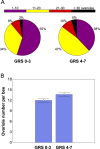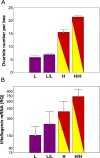Sensory response system of social behavior tied to female reproductive traits
- PMID: 18852894
- PMCID: PMC2560998
- DOI: 10.1371/journal.pone.0003397
Sensory response system of social behavior tied to female reproductive traits
Abstract
Background: Honey bees display a complex set of anatomical, physiological, and behavioral traits that correlate with the colony storage of surplus pollen (pollen hoarding). We hypothesize that the association of these traits is a result of pleiotropy in a gene signaling network that was co-opted by natural selection to function in worker division of labor and foraging specialization. By acting on the gene network, selection can change a suite of traits, including stimulus/response relationships that affect individual foraging behavior and alter the colony level trait of pollen hoarding. The 'pollen-hoarding syndrome' of honey bees is the best documented syndrome of insect social organization. It can be exemplified as a link between reproductive anatomy (ovary size), physiology (yolk protein level), and foraging behavior in honey bee strains selected for pollen hoarding, a colony level trait. The syndrome gave rise to the forager-Reproductive Ground Plan Hypothesis (RGPH), which proposes that the regulatory control of foraging onset and foraging preference toward nectar or pollen was derived from a reproductive signaling network. This view was recently challenged. To resolve the controversy, we tested the associations between reproductive anatomy, physiology, and stimulus/response relationships of behavior in wild-type honey bees.
Methodology/principal findings: Central to the stimulus/response relationships of honey bee foraging behavior and pollen hoarding is the behavioral trait of sensory sensitivity to sucrose (an important sugar in nectar). To test the linkage of reproductive traits and sensory response systems of social behavior, we measured sucrose responsiveness with the proboscis extension response (PER) assay and quantified ovary size and vitellogenin (yolk precursor) gene expression in 6-7-day-old bees by counting ovarioles (ovary filaments) and by using semiquantitative real time RT-PCR. We show that bees with larger ovaries (more ovarioles) are characterized by higher levels of vitellogenin mRNA expression and are more responsive to sucrose solutions, a trait that is central to division of labor and foraging specialization.
Conclusions/significance: Our results establish that in wild-type honey bees, ovary size and vitellogenin mRNA level covary with the sucrose sensory response system, an important component of foraging behavior. This finding validates links between reproductive physiology and behavioral-trait associations of the pollen-hoarding syndrome of honey bees, and supports the forager-RGPH. Our data address a current evolutionary debate, and represent the first direct demonstration of the links between reproductive anatomy, physiology, and behavioral response systems that are central to the control of complex social behavior in insects.
Conflict of interest statement
Figures


Similar articles
-
PDK1 and HR46 gene homologs tie social behavior to ovary signals.PLoS One. 2009;4(4):e4899. doi: 10.1371/journal.pone.0004899. Epub 2009 Apr 2. PLoS One. 2009. PMID: 19340296 Free PMC article.
-
The effects of foraging role and genotype on light and sucrose responsiveness in honey bees (Apis mellifera L.).Behav Brain Res. 2009 Dec 14;205(1):132-7. doi: 10.1016/j.bbr.2009.07.022. Epub 2009 Jul 28. Behav Brain Res. 2009. PMID: 19643145
-
Support for the reproductive ground plan hypothesis of social evolution and major QTL for ovary traits of Africanized worker honey bees (Apis mellifera L.).BMC Evol Biol. 2011 Apr 13;11:95. doi: 10.1186/1471-2148-11-95. BMC Evol Biol. 2011. PMID: 21489230 Free PMC article.
-
8. The development and evolution of division of labor and foraging specialization in a social insect (Apis mellifera L.).Curr Top Dev Biol. 2006;74:253-86. doi: 10.1016/S0070-2153(06)74008-X. Curr Top Dev Biol. 2006. PMID: 16860670 Free PMC article. Review.
-
The curious case of aging plasticity in honey bees.FEBS Lett. 2010 Jun 18;584(12):2496-503. doi: 10.1016/j.febslet.2010.04.007. Epub 2010 Apr 10. FEBS Lett. 2010. PMID: 20385132 Review.
Cited by
-
Organ-specific transcriptome analysis reveals differential gene expression in different castes under natural conditions in Apis cerana.Sci Rep. 2021 May 28;11(1):11267. doi: 10.1038/s41598-021-90635-3. Sci Rep. 2021. PMID: 34050219 Free PMC article.
-
PDK1 and HR46 gene homologs tie social behavior to ovary signals.PLoS One. 2009;4(4):e4899. doi: 10.1371/journal.pone.0004899. Epub 2009 Apr 2. PLoS One. 2009. PMID: 19340296 Free PMC article.
-
Impact of odorants on perception of sweetness by honey bees.PLoS One. 2023 Dec 27;18(12):e0290129. doi: 10.1371/journal.pone.0290129. eCollection 2023. PLoS One. 2023. PMID: 38150461 Free PMC article.
-
Genetics of reproduction and regulation of honeybee (Apis mellifera L.) social behavior.Annu Rev Genet. 2012;46:97-119. doi: 10.1146/annurev-genet-110711-155610. Epub 2012 Aug 28. Annu Rev Genet. 2012. PMID: 22934646 Free PMC article.
-
Queen and young larval pheromones impact nursing and reproductive physiology of honey bee (Apis mellifera) workers.Behav Ecol Sociobiol. 2014;68(12):2059-2073. doi: 10.1007/s00265-014-1811-y. Epub 2014 Sep 25. Behav Ecol Sociobiol. 2014. PMID: 25395721 Free PMC article.
References
-
- West-Eberhard MJ. Flexible Strategy and Social Evolution. In: Itô LY, Brown JL, Kikkawa J, editors. Animal Societies: Theories and Fact. Tokyo: Japan Sci. Soc. Press; 1987. pp. 35–51.
-
- Page RE, Linksvayer T, Amdam GV. Social life from solitary regulatory networks: a paradigm for insect sociality. In: Gadau G, Fewell JH, editors. Organization of Insect Societies. Cambridge, MA: Harvard University Press; 2008. in press.
Publication types
MeSH terms
Substances
Grants and funding
LinkOut - more resources
Full Text Sources

